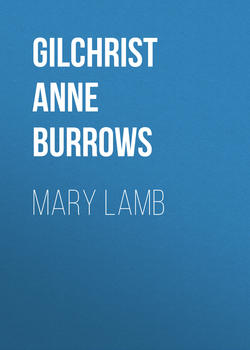Читать книгу Mary Lamb - Gilchrist Anne Burrows, Уолт Уитмен - Страница 1
PREFACE
ОглавлениеI am indebted to Mrs. Henry Watson, a granddaughter of Mr. Gillman, for one or two interesting reminiscences, and for a hitherto unpublished "notelet" by Lamb (p. 248), together with an omitted paragraph from a published letter (p. 84), which confirms what other letters also show, – that the temporary estrangement between Lamb and Coleridge was mainly due to the influence of the morbid condition of mind of their common friend, Charles Lloyd.
My thanks are also due to Mr. Potts for some bibliographic details respecting the various editions of the Tales from Shakespeare.
Reprinted here, for the first time, is a little essay on Needle-work (regarded from an industrial, not an "art" point of view), by Mary Lamb (p. 186), unearthed from an obscure and long-deceased periodical —The British Lady's Magazine– for which I have to thank Mr. Edward Solly, F.R.S.
The reader will find, also, the only letter that has been preserved from Coleridge to Lamb, who destroyed all the rest in a moment of depression (pp. 24-6). This letter is given, without exact date or name of the person to whom it was addressed, in Gillman's unfinished Life of Coleridge, as having been written "to a friend in great anguish of mind on the sudden death of his mother," and has, I believe, never before been identified. But the internal evidence that it was to Lamb is decisive.
In taking Mary as the central figure in the following narrative, woven mainly from her own and her brother's letters and writings, it is to that least explored time, from 1796 to 1815 – before they had made the acquaintance of Judge Talfourd, Proctor, Patmore, De Quincey, and other friends, who have left written memorials of them – that we are brought nearest; the period, that is, of Charles' youth and early manhood. For Mary was the elder by ten years; and there is but little to tell of the last twenty of her eighty-three years of life, when the burthen of age was added to that of her sad malady.
The burial-register of St. Andrew's, Holborn, in which church-yard Lamb's father, mother and aunt Hetty were buried, shows that the father survived his wife's tragic death nearly three years instead of only a few months as Talfourd, and others following him, have supposed. It is a date of some interest because not till then did brother and sister begin together their life of "double singleness" and entire mutual devotion. Also, in sifting the letters for facts and dates, I find that Lamb lived in Chapel Street, Pentonville not, as Talfourd and Proctor thought, a few months, but three years, removing thither almost immediately after the mother's death. It is a trifle, yet not without interest to the lovers of Lamb, for these were the years in which he met in his daily walks, and loved but never accosted, the beautiful Quakeress "Hester," whose memory is enshrined in the poem beginning "When Maidens such as Hester die."
Anne Gilchrist.
Keats Corner, Hampstead.
